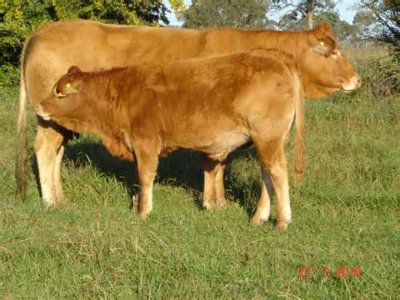Limousin Cattle
Category: Cattle - Cow

Facts about Limousin Cattle, The Limousin Cattle is an ancient breed that was developed in the province of Limousin in central France. The Limousin Cattle were selected for their superior meat qualities, and were often left to fend for themselves in winters. "Fear of cattle Bovinophobia". "Scientific name for cattle Bovine".
Description
The Limousin Cattle has a rich gold colored body, with lighter circles around the muzzle and the eyes, and shading to lighter color on the legs. The Limousin Cattle can also have a black coating. It has a small and short head with broad forehead, with a short neck. The French Limousin Cattle have horns, but polled Limousin Cattle have been developed in Australia. Most of the horned Limousin Cattle are to be De-horned at the calf stage. The Limousin Cattle are generally intermediate in size.
The Limousin Cattle bull can weigh up to 2,645 pounds (1200 kg) and stands to about 57 inches (145 cm) tall. The cow averages to about 1,540 pounds (700 kg) on weight and stands to about 53 inches (135 cm) tall at the shoulder.
Characteristics
The Limousin Cattle are a hardy breed, they can adapt to diverse climatic conditions and to a wide range of management systems. The Limousin Cattle calve is born with a lower weights which leads to minimum calving troubles. The crossbred heifers and steers have a dressing percentages of 58 to 63 percent which is a bit higher compared to the others. The Limousin Cattle have high meat to born ratio with low fats giving an outstanding yields good meat. The Limousin Cattle meat is finely textured, low in fats and cholesterol and tender.
Limousin Cattle breed of cattle are generally efficient – with moderate maturity size and an excellent foraging ability, they can walk for long distances in search for pasture. They have above average conversion rates.
For crossbreeding purpose, it will pass on its superior carcass characteristics.
Health issues
You will notice form its hardy trait that Limousin Cattle fall ill less often, but for good raring practices one has to ensure that the Limousin Cattle are vaccinated well and given a regular check-up from a veterinary.
Diet
With their foraging ability, the Limousin Cattle breed will do well in large fields with plenty of pasture. They can also do ok with dried hey. One also needs to supplement with minerals and salt blocks. The different type of salt will be administered depending on the purpose it serves to the animal.
Water is vital for every animal; ensure there is plenty of fresh and clean water for the animal. The Limousin Cattle usually consume large volume especially during the extreme hot seasons.
All in All Limousin Cattle is a docile breed and have much to offer in terms of introducing mass to the lighter breeds while still maintaining low birth weights.
Beef is consumed through out the world. Beef is eaten as roasts, steaks, and hamburgers. The other way it is used is meat by-products, this includes brains, intestines, horns, hides, diaphragm, heart, hoofs, hair, lips, snout, ears, bones and tongue. These meat by-products are used in many products that include margarine, dog food, makeup, chewing gum, marshmallows, shampoo, ice cream, gelatin, cement, chalk, and tennis racquets, fertilizer, piano keys, glues, wallpaper and strings for musical instruments. There are three different phases the way Beef is raised, the calves are raised on farm land and out in the pasture, used as feeder cattle they feed in the pasture on grass and crop residue. Finally the beef goes to troughs of feed, where the beef is fattened to be slaughter. The slaughterhouse is where the beef gets cut up and divided into different cuts, the (meat packer). This is were it is packed and sent to meat distributors where it goes to butchers and super markets.

 Back To Category Cattle - Cow
Back To Category Cattle - Cow